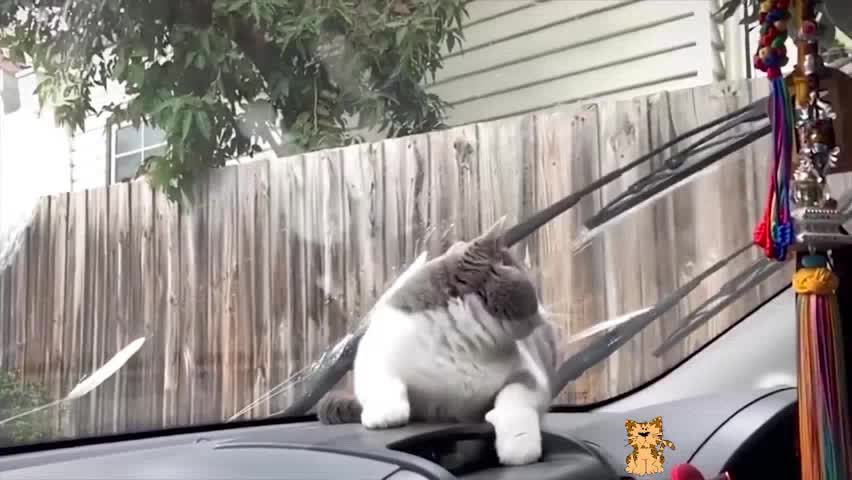Premium Only Content

Baby Cats Video And Funny Animals
You may love your cat, but you may not be fully aware of just how cool her she — and her overall species — really is. For example, did you know that cats have an extra organ that allows them to taste scents? Or that they developed meowing as a way to communicate exclusively with humans?
Clearly, there’s more to your little feline friend than meets the eye. So, to help you fully appreciate how awesome cats are, we asked cat care professionals on Care.com — namely, cat sitters, boarders, and groomers — to share their favorite fun facts about these mystical creatures. We then pulled together a list of the 101 most amusing cat facts that you can share with your friends and family. I just share with you some special points about cats.
Facts About Cat Anatomy & Physiology
A house cat’s genome is 95.6 percent tiger, and they share many behaviors with their jungle ancestors, says Layla Morgan Wilde, a cat behavior expert and the founder of Cat Wisdom 101. These behaviors include scent marking by scratching, prey play, prey stalking, pouncing, chinning, and urine marking.
Cats are believed to be the only mammals who don’t taste sweetness.
Cats are nearsighted, but their peripheral vision and night vision are much better than that of humans.
Cats are supposed to have 18 toes (five toes on each front paw; four toes on each back paw).
Cats can jump up to six times their length.
Cats’ claws all curve downward, which means that they can’t climb down trees head-first. Instead, they have to back down the trunk.
Cats’ collarbones don’t connect to their other bones, as these bones are buried in their shoulder muscles.
Cats have 230 bones, while humans only have 206.
Cats have an extra organ that allows them to taste scents in the air, which is why your cat stares at you with her mouth open from time to time.
Cats have whiskers on the backs of their front legs, as well.
Cats have nearly twice the amount of neurons in their cerebral cortex as dogs.
Cats have the largest eyes relative to the head size of any mammal.
Cats make very little noise when they walk around. The thick, soft pads on their paws allow them to sneak up on their prey — or you!
Cats’ rough tongues can lick a bone clean of any shred of meat.
Cats use their long tails to balance themselves when they’re jumping or walking along narrow ledges.
Cats use their whiskers to “feel” the world around them to determine which small spaces they can fit into. A cat’s whiskers are generally about the same width as its body. (This is why you should never, EVER cut their whiskers.)
Cats walk like camels and giraffes: They move both of their right feet first, then move both of their left feet. No other animals walk this way.
Male cats are more likely to be left-pawed, while female cats are more likely to be right-pawed.
Though cats can notice the fast movements of their prey, it often seems to them that slow-moving objects are actually stagnant.
Some cats are ambidextrous, but 40 percent are either left- or right-pawed.
Some cats can swim.
Some cats have more than 18 toes. These extra-digit felines are referred to as being “polydactyl.”
↓↓↓↓↓↓↓↓↓↓↓↓↓↓↓↓↓↓
-
 LIVE
LIVE
GussyWussie
6 hours agoReturning to one of the Best Zelda Games - Breath of the Wild
538 watching -
 2:33:50
2:33:50
Wahzdee
2 hours agoMorning Grind: Arena Breakout vs Tarkov Showdown 🎮 - Wahzvember Day 25
14.7K2 -
 0:41
0:41
World Nomac
18 hours agoThe side of Las Vegas they don't want you to know about
6.89K -
 LIVE
LIVE
Film Threat
7 hours agoVERSUS: WICKED VS GLADIATOR II | Film Threat Versus
256 watching -
 2:06:30
2:06:30
Barstool Yak
7 hours agoThe Yak with Big Cat & Co. Presented by Rhoback | The Yak 11-25-24
16.2K3 -
 1:43:44
1:43:44
The Quartering
5 hours agoDr Disrespect Leaves Youtube For Rumble! With Rumble CEO Chris Pavlovski
102K56 -
 50:55
50:55
Grant Stinchfield
3 hours ago $0.99 earnedMy Trip To The Emergency Room Exposed the Our Joke of a Health Care System
10.2K3 -

RyanMatta
1 day ago $1.82 earnedOPERATION AMBER ALERT | CHILD TRAFFICKING DOCUMENTARY | EXECUTIVE PRODUCER RYAN MATTA
9.07K15 -
 14:14
14:14
TimcastIRL
1 day agoJoe Rogan ROASTS The View For Saying He BELIEVES IN DRAGONS In HILARIOUS MOCKERY
48.4K81 -
 2:17:04
2:17:04
Side Scrollers Podcast
7 hours agoDoc Disrespect ON RUMBLE, PlayStation To Rival Nintendo | Side Scrollers
44.5K6